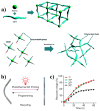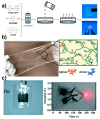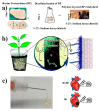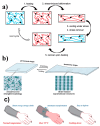Stimuli-Responsive Polymer Actuator for Soft Robotics
- PMID: 39339124
- PMCID: PMC11436224
- DOI: 10.3390/polym16182660
Stimuli-Responsive Polymer Actuator for Soft Robotics
Abstract
Polymer actuators are promising, as they are widely used in various fields, such as sensors and soft robotics, for their unique properties, such as their ability to form high-quality films, sensitivity, and flexibility. In recent years, advances in structural and fabrication processes have significantly improved the reliability of polymer sensing-based actuators. Polymer actuators have attracted considerable attention for use in artificial or biohybrid systems, as they have the potential to operate under diverse conditions with high durability. This review briefly describes different types of polymer actuators and provides an understanding of their working mechanisms. It focuses on actuation modes controlled by diverse or multiple stimuli. Furthermore, it discusses the fabrication processes of polymer actuators; the fabrication process is an important consideration in the development of high-quality actuators with sensing properties for a wide range of applications in soft robotics. Additionally, the high potential of polymer actuators for use in sensing technology is examined, and the latest developments in the field of polymer actuators, such as the development of biohybrid polymers and the use of polymer actuators in 4D printing, are briefly described.
Keywords: actuator; external stimuli; polymers; sensor; soft biohybrid robotics.
Conflict of interest statement
Author Sang-Nam Lee was employed by Uniance Gene Inc. The remaining authors declare that the research was conducted in the absence of any commercial or financial relationships that could be construed as a potential conflict of interest.
Figures
















References
-
- Wei M., Gao Y., Li X., Serpe M.J. Stimuli-Responsive Polymers and Their Applications. Polym. Chem. 2017;8:127–143. doi: 10.1039/C6PY01585A. - DOI
-
- Ahn J., Gu J., Choi J., Han C., Jeong Y., Park J., Cho S., Oh Y.S., Jeong J.H., Amjadi M., et al. A Review of Recent Advances in Electrically Driven Polymer-Based Flexible Actuators: Smart Materials, Structures, and Their Applications. Adv. Mater. Technol. 2022;7:2200041. doi: 10.1002/admt.202200041. - DOI
-
- Alberti G., Zanoni C., Losi V., Magnaghi L.R., Biesuz R. Current Trends in Polymer Based Sensors. Chemosensors. 2021;9:108. doi: 10.3390/chemosensors9050108. - DOI
-
- Pavel I.A., Lakard S., Lakard B. Flexible Sensors Based on Conductive Polymers. Chemosensors. 2022;10:97. doi: 10.3390/chemosensors10030097. - DOI
Publication types
Grants and funding
LinkOut - more resources
Full Text Sources

